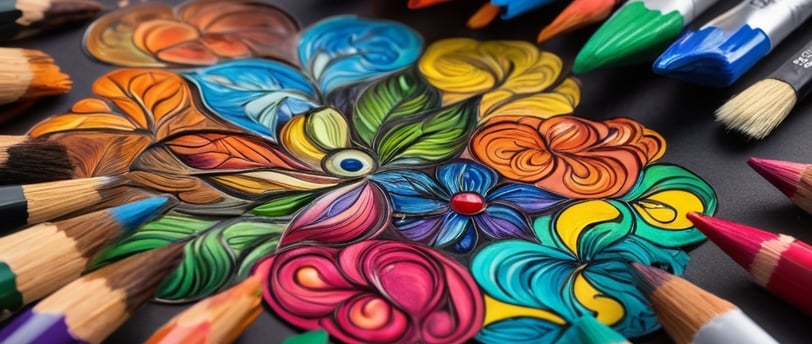Exploring Materials and Tools for Coloring
A Guide for Enthusiasts
12/27/20232 min read


Coloring, an activity cherished by children and adults alike, has evolved into a sophisticated art form with a myriad of tools and materials available. Whether you're a beginner or an experienced colorist, understanding the various coloring tools and materials can significantly enhance your experience. In this blog post, we'll explore the different materials and tools available for coloring, helping you to make informed choices for your artistic journey.
1. Coloring Mediums
Colored Pencils: A favorite among colorists, colored pencils offer precision and a wide range of hues. They are perfect for detailed work and layering colors. High-quality pencils have rich pigmentation and blend beautifully. Check these pencils on Amazon.
Crayons: Ideal for children and nostalgic adults, crayons are wax-based and offer bright, bold colors. They're easy to use, affordable, and great for covering large areas quickly. Check these crayons on Amazon.
Markers: Markers are loved for their vibrant colors and ease of application. They come in various types including water-based, alcohol-based, and brush-tip markers. While they offer a smooth coloring experience, they can bleed through paper, so choosing the right paper is crucial. Check these markers on Amazon.
Gel Pens: Gel pens are perfect for adding details and embellishments. They come in a variety of colors, including metallics and pastels, and are excellent for adding a touch of sparkle or highlighting to your artwork. Check these gel pens on Amazon.
Watercolor Pencils: These pencils offer the best of both worlds - the control of a pencil with the blendability of watercolors. When brushed with water, they create a beautiful, painterly effect. Check these watercolor pencils on Amazon.
2. Paper Quality
Weight and Texture: The quality of paper is crucial in coloring. Heavier paper (higher GSM) is ideal for markers and watercolors as it prevents bleeding and buckling. Textured paper is great for colored pencils as it holds the pigment better.
Coloring Books vs. Loose Sheets: While coloring books are convenient, loose sheets offer flexibility and better paper quality. They also allow you to use mediums that might bleed through the pages of a coloring book.
3. Accessories
Sharpeners: A good sharpener is essential, especially for colored pencils. It ensures a fine point for detailed work and helps in getting the most out of your pencils. Check out this cool sharpener on Amazon.
Erasers: For colored pencils, an erasable or kneaded eraser can be useful for correcting mistakes or creating highlights. Check out this eraser on Amazon.
Blending Tools: Blending stumps, tissues, or blending pencils can be used to seamlessly blend colors, especially when working with colored pencils or crayons. Check out these blending pencils on Amazon.
4. Storage and Care
Organizers: Proper storage is key to preserving your coloring materials. Organizers, cases, or racks can help keep your tools in good condition and easily accessible.
Care Tips: Avoid exposing your coloring materials to extreme temperatures. Keeping markers and pens horizontally can help prevent them from drying out.
5. Experimentation and Personal Preference
Ultimately, the choice of materials and tools comes down to personal preference and the style of coloring you enjoy. Experimenting with different mediums can help you discover what works best for you and allows you to develop your unique coloring style.
Final Thoughts
The materials and tools for coloring are as diverse as the artists who use them. Whether you're looking to achieve precision, experiment with textures, or simply enjoy the act of coloring, there's a range of options to suit your needs. Remember, the best tools are the ones that feel right for you and bring joy to your coloring experience. Happy coloring!
